Overview
- Description
- Tax records pertaining to the business owned by Max Riess in Berlin, which specialized in the sales of mens accessories, including socks, gloves, and neckties. The records pertain mostly to income taxes paid by Riess during the late 1930s, up until his business was expropriated in 1941, and include taxes he had paid on his personal belongings and business inventories as part of the "Judenvermoegensabgabe" and other taxes targeting Jews during this period.
Tax records pertaining to the business owned by Max Riess in Berlin, which specialized in the sales of men’s accessories, including socks, gloves, and neckties. The records pertain mostly to income taxes paid by Riess during the late 1930s, up until his business was expropriated in 1941, and include taxes he had paid on his personal belongings and business inventories as part of the "Judenvermögensabgabe" and other taxes targeting Jews during this period.
Through the records that Riess kept, including correspondence with officials at the tax offices in Berlin-Mitte and Scharnhorst, a picture emerges of the declining sales and income of Riess’s business as it was targeted as a Jewish-owned business, and as additional taxes were levied on him, including the “Judenvermögensabgabe,” or the tax levied on German Jews following Kristallnacht in 1938. Riess was forced to accept a loan from his widowed mother, Olga Riess, but even this didn’t prevent the eventual loss of his business. Aryanization procedures were initiated in 1939, and by February 1941 he had recorded the dissolution of his business with the tax office in Berlin-Scharnhorst. Documents from 1942 show the forced collection of clothing from members of the Jewish Community of Berlin, and the items that Riess and his mother were forced to hand over.
An additional file of print outs of e-mails from 2010, show how the Berlin office of the European Council of Jewish Communities sought to have a memorial “Stolperstein” placed on the sidewalk of Invalidenstrasse 156, outside of the building that once housed Riess’s business. This action was taken after a member of the Berlin office of the Council had received this file of Riess’s tax records, and decided to find a way to memorialize Riess. - Date
-
inclusive:
1930-1942
- Credit Line
- United States Holocaust Memorial Museum Collection, The Abraham and Ruth Goldfarb Family Acquisition Fund
- Collection Creator
- Max Riess
- Biography
-
Max Riess was born in Berlin-Charlottenburg on 10 February, 1897. He operated a business on Invalidenstrasse 156 in Berlin, which sold socks, gloves, and neckties. His business was dissolved in 1941, and Riess was transported from Berlin to Auschwitz on 4 August 1943, on transport number 40. His fate is unknown and he is presumed to have perished there. [Source: Gedenkbuch Berlins: der juedischen Opfer des Nationalsozialismus; and internal documentation in Max Riess papers].
Physical Details
- Language
- German
- Extent
-
5 folders
- System of Arrangement
- The collection is arranged in five file folders, and then subdivided by topic within each folder, and within chronological order in each sub-folder.
Rights & Restrictions
- Conditions on Access
- There are no known restrictions on access to this material.
- Conditions on Use
- Material(s) in this collection may be protected by copyright and/or related rights. You do not require further permission from the Museum to use this material. The user is solely responsible for making a determination as to if and how the material may be used.
Keywords & Subjects
Administrative Notes
- Holder of Originals
-
United States Holocaust Memorial Museum
- Legal Status
- Permanent Collection
- Provenance
- Acquired from the Kedem Auction House, Ltd. in 2013.
- Funding Note
- The acquisition of this collection was made possible by The Abraham and Ruth Goldfarb Family Acquisition Fund.
- Record last modified:
- 2024-05-23 15:40:18
- This page:
- https://collections.ushmm.org/search/catalog/irn62088
Additional Resources
Download & Licensing
In-Person Research
- Available for Research
- Plan a Research Visit
-
Request in Shapell Center Reading Room
Bowie, MD
Contact Us
Also in Jewish paper based ephemera
Robert Edward Edmondson anti-Semitic broadsides: Six broadsides, issued by the Edmondson Economic Service, under the following titles and dates: "'Invisible Government:' The Hidden Autocratic Minority Menace to American Democracy" (18 May 1934); "Prof. Felix Frankfurter" (4 July 1934); "Are You a Communist, Mr. Dickstein?" (15 December 1934); "Justice Brandeis Unfit?" (15 March 1935); "Jews Off Gold?" (10 August 1937); "The Jewish Hymn Onward Christian Soldiers--To Make the World Safe for Communistic Jewry!" (10 January 1939). Announcement of protest against the Jewish boycott of Germany, Brooklyn, New York, April 1934: Broadside announcement, calling on German-Americans of Brooklyn to protest the Jewish boycott of German businesses by attending a mass protest, to be held at Ridgewood Grove, Brooklyn, on the evening of April 8, 1934. The protest was organized by a group called "Friends of the New Germany." Max Riess papers: Tax records pertaining to the business owned by Max Riess in Berlin, which specialized in the sales of mens accessories, including socks, gloves, and neckties. The records pertain mostly to income taxes paid by Riess during the late 1930s, up until his business was expropriated in 1941, and include taxes he had paid on his personal belongings and business inventories as part of the "Judenvermoegensabgabe" and other taxes targeting Jews during this period. Yosif Yosifov papers: Correspondence, names lists, and other documentation related to Yosifov's efforts to assist Bulgarian Jews of the Beitar and Revisionist movements with immigration to Palestine in the early 1940s. Includes correspondence with members of the New Zionist Organization. The fate of Jews, Polish refugees, in Russia: Mr. A. Dobkin's mission to Persia. News from Eretz Israel, from the Diaspora, and the movement. Postcard dedicated to Zeev Jabotinsky Estonian propaganda poster denigrating Roosevelt and the USA Political pro-Jewish poster - Holland, 1940s
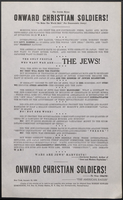
Robert Edward Edmondson antisemitic broadsides
Document
Six broadsides, issued by the Edmondson Economic Service, under the following titles and dates: "'Invisible Government:' The Hidden Autocratic Minority Menace to American Democracy" (18 May 1934); "Prof. Felix Frankfurter" (4 July 1934); "Are You a Communist, Mr. Dickstein?" (15 December 1934); "Justice Brandeis Unfit?" (15 March 1935); "Jews Off Gold?" (10 August 1937); "The Jewish Hymn Onward Christian Soldiers--To Make the World Safe for Communistic Jewry!" (10 January 1939).
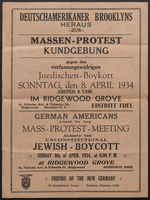
Announcement of protest against the Jewish boycott of Germany, Brooklyn, New York, April 1934
Document
Broadside announcement, calling on German-Americans of Brooklyn to protest the Jewish boycott of German businesses by attending a mass protest, to be held at Ridgewood Grove, Brooklyn, on the evening of April 8, 1934. The protest was organized by a group called "Friends of the New Germany."
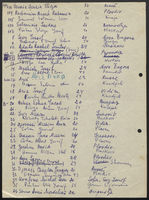
Yosif Yosifov papers
Document
Correspondence, names lists, and other documentation related to Yosifov's efforts to assist Bulgarian Jews of the Beitar and Revisionist movements with immigration to Palestine in the early 1940s. Includes correspondence with members of the New Zionist Organization.
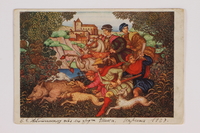
Postcard of a hunting tapestry miniature by Arthur Szyk inscribed to a friend
Object
French picture postcard of a miniature painting by Arthur Szyk inscribed to his friend Ze’ev (Vladimir) Jabotinsky in 1928. It depicts a medieval tapestry, La Battue aux Sangliers dans le Quercy [Hunting boars in Quercy]. Szyk was a Polish-born Jewish artist renowned for his miniatures, illuminations, and illustrations. Vladimir Jabotinsky (1880-1940) was the leader of the Revisionist Zionist movement, and a founder of Haganah and the Betar youth movement. In 1919, Szyk, originally from Łódź, Poland, moved to Paris where he met Jabotinsky. After the German invasion of Poland in September 1939, Szyk's work focused on anti-Nazi political cartoons. In 1940, he went to the US where he became a leading anti-Fascist editorial caricaturist and brought attention to the mass murder of Europe’s Jews by Nazi Germany.

Propaganda poster in Estonian picturing Roosevelt as the friend of US criminals
Object
Anti-American propaganda poster issued in Estonia after it was annexed by Nazi Germany in September 1941. The poster accuses Roosevelt of being a liar and associate of gangsters such as Al Capone. It calls for the destruction of Jews and this criminal race. In July 1941, Germany invaded Estonia and made it part of the Reich Commissariat Ostland, a German civilian administration. Estonia was under German rule until September 1944, when it was annexed by the Soviet Union.
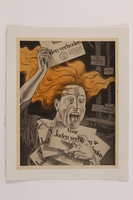
Book illustration of an allegorical cartoon on the destruction of Dutch Jews
Object
De Waanzin Breekt Los [The Madness Breaks Loose], a print of a drawing by Dutch cartoonist Leendert Jordaan illustrating the terror and coming destruction of the Jewish population of the Netherlands during the German occupation, May 1940- May 1945. Netherlands had an SS controlled administration which put in place policies to persecute and isolate Jews. In 1941, Jews forbidden [Voor Joden Verboden] signs were posted all over Amsterdam. In 1942, the Dutch Nazi Party (NSB) member, Jan Feitsma, who from 1941 was the Attorney General of Amsterdam, had all the signs replaced with ones he designed bearing his name, as shown in the drawing. Feitsma collaborated with the Germans in the 1941 imprisonment of thousands of Jews in forced labor camps, and in 1942, with the deportations to concentration camps. In 1943, there was an assassination attempt on Feitsma. He was killed in a second attempt on February 2, 1945. The drawing was published in a book of Jordaan's work, Nachtmerrie over Nederland : een herinnerings-album [Nightmare in the Netherlands] in 1945 after the war ended in May.
The fate of Jews, Polish refugees, in Russia: Mr. A. Dobkin's mission to Persia
Document
Contains a document issued by the information bureau of the Jewish Agency, marked "Not for Publication." September 8, 1942. 11 pp,
News from Eretz Israel, from the Diaspora, and the movement
Document
Consists of a pamphlet entited "News from Eretz Israel, from the Diaspora and the movement," published by the National Committee for the Jewish Soldier; dated May 9, 1944. Issue no. 21. 6 pp, 33 cm.



